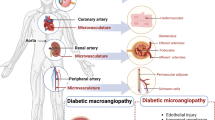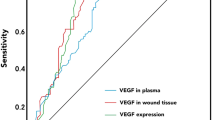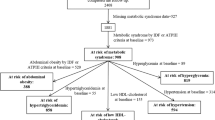Abstract
Purpose
This study was planned to study the relationship between vascular endothelial growth factor (VEGF) as an angiogenic factor and different micro- and macrovascular complications in type II diabetic patients and look for a possible role of control on the serum level of VEGF.
Methods
The study included 55 type II diabetic patients, 10 of them were not complicated with any of the vascular complications of type II diabetes mellitus (DM) (group 1), 21 patients had microvascular complication either retinopathy, nephropathy, or neuropathy (group 2), 14 patients had macrovascular complications either coronary artery disease or peripheral vascular disease (group 3), and 10 patients with mixed micro- and microvascular complications (group 4), as well as 15 healthy subjects served as control group. All subjects were subjected to complete clinical examination, including fundus examination, proper investigations with stress on electrocardiography, electromyography, nerve conduction velocity, Doppler study of the peripheral arteries, and laboratory investigations such as complete blood count, liver function test, serum creatinine, 24-h urinary albumin excretion, lipid profile, fasting and 2-h postprandial blood glucose, glycosylated haemoglobin (HbA1c), and serum VEGF.
Results
The study revealed that there was a highly significant increase in the serum VEGF in the diabetic patients compared with the control group. The P-value (P<0.001) was detected and there was also a highly significant increase in the serum VEGF in the patients with different micro- and macrovascular diabetic complications compared with uncomplicated diabetic group (P<0.001). A highly significant increase in the serum VEGF in diabetic patients with proliferative diabetic retinopathy was detected compared with non-proliferative diabetic retinopathy (40.55±8.28 vs20.3±2.45, P<0.001) and in diabetic nephropathic patients with macroalbuminuria compared with those with microalbuminuria (36.14±6.99 vs19.42±2.44, P<0.001). The reduction of the serum VEGF in a group of diabetic patients with poor control when their diabetic state was corrected through 4 months follow-up was highly significant (17.29±1.61 before vs9.39±0.82 after control P<0.001), as well as the reduction of the serum VEGF, which was observed in a group of patients with proliferative diabetic retinopathy (PDR) when proper pan retinal photocoagulation (PRP) was applied to their retinae with 4 months follow-up (40.55±8.28 before vs21.15±1.76 after PRP, P<0.001). On the other hand, the impact of some clinical and laboratory parameters of our diabetic patients on the serum VEGF revealed significant positive correlations between serum VEGF and age of the patients, duration of diabetes, systolic and diastolic blood pressure, body mass index, fasting and 2-h postprandial blood glucose, HbA1c, serum creatinine, degree of albuminuria and total cholesterol, LDL, and platelet count.
Conclusion
Serum VEGF was significantly increased in diabetic patients especially with micro- and macrovascular complications and the proper control of diabetes reduced the elevation of serum VEGF in uncontrolled diabetic patients, and in patients with PDR with proper PRP, indicating that VEGF is an angiogenic factor that reflects the degree of neovascularization in diabetic complications.
Similar content being viewed by others
Log in or create a free account to read this content
Gain free access to this article, as well as selected content from this journal and more on nature.com
or
References
Jean-Sebastein S, Bernard IL . Molecular basis of angiopathy in DM. Circ Res (2006); 98: 4–6.
Aiello LP, Wong JS . Role of vascular endothelial growth factor in diabetic vascular complications. Kidney Int Suppl 2000; 77: 113–119.
Shiboya M . Structure function of VEGF-I/VEGF receptor system involved in angiogenesis. Cell Struct Funct 2001; 26 (l): 25–35.
Bates DO, Lodwick D, Williams B . Vascular endothelial growth factor microvascular permeability. Microcirculation 1999; 6 (2): 83–96.
Kimura I, Honda R, Kokai H, Kkabe M . Vascular endothelial growth factor promotes cell cycle transition from G0 to Gl phase in subcultured endothelial cells of diabetic rat thoracic aorta. Jpn J Pharmacol 2000; 83 (l): 47–55.
Santilli F, Spagnoli A, Mohn A . Increased vascular endothelial growth factor serum concentrations may help to identify patients with onset of type 1 diabetes during childhood at risk for developing persistent microalbuminuria. J Clin Endocrinol Metab 2001; 86 (8): 3871–3876.
Murohara T, Asahara T, Silver M, Bauters C . Nitric oxide synthase modulates angiogenesis in response to tissue ischemia. J Clin Invest 1998; 101: 2567–2578.
Gerber HP, McMurtrey A, Kowalski J, Minhong Y . Vascular endothelial growth factor regulates endothelial cell survival through the phosphatidylinopsitol 3′- kinase/Akt signal transduction pathway. J Biol Chem 1998; 273: 30336–30343.
Dvorak HF, Brown LF, Detmar M, Dvorak AM . Vascular permeability factor vascular endothelial growth factor, microvascular hyperpermeability, and angiogenesis. Am J Pathol 1995; 146: 1029–1039.
Bates DO, Curry FE . Vascular endothelial growth factor increases microvascular permeability via a Ca2+ dependent pathway. Am J Physiol Heart Circ Physiol 1997; 273: H687–H694.
Esser S, Wolburg K, Wolburg H, Breier G, Kurzchalia T, Risau W . Vascular endothelial growth factor induces endothelial fenestrations in vitro. J Cell Biol 1998; 140: 947–959.
Pepper MS, Ferrara N, Orci L, Montesano R . Potent synergism between vascular endothelial growth factor and basic fibroblast growth factor in the induction of angiogenesis in vitro. Biochem Biophys Res Comm 1992; 189: 824–831.
Unemori EN, Ferrara N, Bauer EA, Amento EP . Vascular endothelial growth factor induces intersitial collagenase expression in human endothelial cells. J Cell Physiol 1992; 153: 557–562.
Pepper MS, Montesano R . Proteolytic balance and capillary morphogenesis. Cell Differ Dev 1990; 32: 319–331.
Boultom M, Foreman D, Williams G, McLeod D . VEGF localization in diabetic retinopathy. Br J Ophthalmol 1998; 82 (5): 561–568.
Ishida S, Shinoda K, Kawashima S, Oguchi Y, Okada Y, Ikeda E . Coexpression of VEGF receptors VEGF-R2 and neurophilin-1 in proliferative diabetic retinopathy. Invest Ophthalmol Vis Sei 2000; 41: 1649–1656.
Smith G, McLeod D, Foreman D, Boulton M . Immunolocalisation of the VEGF receptors FLT-1, KDR and FLT-4 in diabetic retinopathy. Br J Ophthalmol 1999; 83: 486–494.
Ozaki H, Seo MS, Ozaki K, Yamada H, Yamada E, Okamoto N . Blockade of vascular endothelial cell growth factor receptor signaling is sufficient to completely prevent retinal neovascularization. Am J Pathol 2000; 156: 697–707.
Aiello LP, Bursell SE, Clermont A, Duth E, Ishii H . Vascular endothelial growth factor induced retinal permeability is mediated by protein kinase C in vivo and suppressed by an orally effective beta-isoform-selective inhibitor. Diabetes 1997; 46: 1473–1480.
Baumgartner L, Pieczek A, Manor O, Blair R, Kearney M, Walsh K et al. Constitutive expression of ph VEGF 165 after intramuscular gene transfer promotes collateral vessel development in patients with critical limb ischemia. Circulation 1998; 97: 1114–1123.
Isner JM, Losordo DW . Therapeutic angiogenesis for heart failure. Nat Med 1999; 5: 491–492.
Expert Committee of the Diagnosis of Classification of DM. Report of the expert committee of diagnosis and classification of DM. Diabetes Care 1997; 20: 1183–1197.
Mizutani M, Kern TS, Lorenzi M . Accelerated death of retinal microvascular cells in human and experimental diabetic retinopathy. J Clin Invest 1996; 97: 2883–2890.
Taguchi T, Brownlee M . The biochemical mechanisms of diabetic tissue damage. Textbook of Diabetes. 3rd edn., Vol. 2, Chap. 2001; 47: 4.
Senthil D, Coundhury GG, McLaurin C, Kasinath BS . Vascular endothelial growth factor induces protein synthesis in renal epithelial cells: a potential role in diabetic nephropathy. Kidney Int 2003; 64 (2): 468–479.
Mittelmarke BM, Psaty BM, Fried LP, Borhani NO, Tracy RP, Rautaharju PM et al. Prevalence of cardiovascular disease among older adults: the cardiovascular health study. Am J Epidemiol 1993; 137: 311–317.
Newman AB, Sutton-Tyrrell K, Voget MT, Kuller LH . Morbidity and mortality in hypertensive adults with a low ankle arm blood pressure index. JAMA 1993; 270: 487–489.
Kakizawa H, Itoh M, Imamura S . The relationship between glycaemic control and plasma vascular endothelial growth factor and endothelin-1 concentration in diabetic patients. Metabolism 2004; 53 (5): 550–555.
Ferrara N, Davis-Smyth T . The biology of vascular endothelial growth factor. Endocr Rev 1997; 18: 4–25.
Leung DW, Cachianes G, Kuang WJ, Goeddel DV, Ferrara N . Vascular endothelial growth factor is a secreted angiogenic mitogen. Science 1989; 246: 1306–1309.
Benjamin LE, Golijanin D, Itin A, Pode D, Keshet E . Selective ablation of immature blood vessels in established human tumors followed vascular endothelial growth factor withdrawal. J Clin Invest 1999; 103: 159–165.
Marsh S, Nakhoul FM, Skorecki K, Rubin A, Miller BP . Hypoxic induction of vascular endothelial growth factor is markedly decreased in diabetic individuals who do not develop retinopathy. Diabetes Care 2000; 23: 1375–1380.
Valabhji O, Dhanjil S, Nicolades AN, Elkeles RS, Sharp P . Correlation between carotid artery dispensability and serum vascular endothelial growth factor concentrations in diabetic subjects and non diabetic subjects. Metabolism 2001; 50 (7): 825–829.
Malamits F, Puchner A, Sarandakoo A, Tziotis A . Serum level of basic fibroblast growth factor and vascular endothelial growth factor in patients with diabetes mellitus. Red Res 1998; 44 (6): 873–875.
Wolf G, Chen S, Ziyaden FN . From the periphery of the glomerular capillary wall toward the center of disease : podocyte injury comes of age in diabetic nephropathy. Diabetes 2005; 54 (6): 1626–1634.
Flyvbjerg A . Growth factors and diabetic complications. Diabetes Med 1990; 7: 387–399.
Zhang SX, Sima J, Wang JJ, Shao C, Fant J, Ma JX . Systemic and periocular deliveries of plasminogen kringle 5 reduce vascular leakage in rat models of oxygen induced retinopathy and diabetes. Curr Eye Res 2005; 30 (8): 681–689.
Murakami T, Arai M, Sunada Y, Nakamura M . VEGF 164 gene transfer by electroporation improves diabetic sensory neuropthy in mice. J Gene Med 2006; 8 (6): 773–781.
Pantsopulos D, Zafiropoulos A, Krambovitis E . Peripheral monocytes from diabetic patients with coronary artry disease display increased bFGF and VEGF mRNA expression. J Tränst Med 2003; 1 (1): 6–21.
Yonemitsu Y, Kaneda Y, Morishita R, Kazunori N, Nakashima Y, Sueishi K . Characterization of in vivo gene transfer into the arterial wall mediated by the Sendai virus (hemagglutinating virus of Japan) liposomes: an effective tool for the in vivo study of arterial diseases. Lab Invest 1996; 75: 313–323.
Makin AJ, Silverman SH, Lip GY . Vascular endothelial growth factor in patients with established peripheral artery disease: a link between angiogenesis and thrombogenesis? Clin Sci (Lond) 2003; 104 (4): 397–404.
Hochberg I, Hoffman A, Levy AP . Regulation of VEGF in diabetic patients with critical limb ischemia. Ann Vasc Surg 2001; 15 (3): 388–392.
Calle EE, Thun MJ, Petrelli JM, Rodriguez C, Health CW . Body mass index and mortality in a prospective cohort of US adults. N Engl J Med 1999; 341: 1097–1105.
Slamler J, Vaccaro O, Neaton JD, Wintworth D . Diabetes, other risk factors and 12 years cardiovascular mortality for men screened in the multiple risk factor intervention trial. Diabetes Care 1993; 16: 343–344.
Turner RC, Millns H, Neil HAW . Risk factors for coronary artery disease in non insulin dependent diabetes mellitus: United Kingdom Prospective Diabetes Study (UKPDS). BMJ 1998; 346: 823–828.
Tzeng TF, Hsiao PJ, Hsieh J . Association of nephropathy ad retinopathy, blood pressure, age in newly diagnosed type 2 diabetes mellitus. Kaohsiung J Med Sci 2001; 17 (6): 294–301.
Murata T, Nakagawa K, Khalil A, Ishibashi T . The relation expression of vascular endothelial growth factor and breakdown of blood retinal barrier in diabetic retinas. Lab Invest 1996; 47: 819–825.
Chiarelli F, Santilli F, Mohn A . Role of growth factors in the development of diabetic complications. Horm Res 2000; 53 (2): 53–67.
Lip PL, Belgore F, Blann AD . Plasma VEGF and soluble VEGF receptor FLI-1 in proliferative retinopathy: relationship to endothelial dysfunction after laser treatment. Invest Ophthalmol Vis Sci 2000; 41 (8): 9.
Shinoda M, Ishida S, Kawashima S, Wakabayashi T, Uchita M, Matsuzaki T et al. Clinical factors related to aqueous levels of vascular endothelial growth factor, hepatocyte growth factor in proliferative diabetic retinopathy. Curr Eye Res 2000; 21 (2): 655–661.
Endo M, Yanagisawa K, Tsuchida K . Increased levels of vascular endothelial growth factor and advanced glycation end products in aqueous humor of patients with diabetic retinopathy. Horm Metabol Res 2001; 33 (5): 317–322.
Author information
Authors and Affiliations
Corresponding author
Ethics declarations
Competing interests
The authors declare no conflict of interest.
Rights and permissions
About this article
Cite this article
Mahdy, R., Nada, W., Hadhoud, K. et al. The role of vascular endothelial growth factor in the progression of diabetic vascular complications. Eye 24, 1576–1584 (2010). https://doi.org/10.1038/eye.2010.86
Received:
Revised:
Accepted:
Published:
Issue date:
DOI: https://doi.org/10.1038/eye.2010.86
Keywords
This article is cited by
-
The relationship between vascular endothelial growth factor-A serum level and the severity of diabetic peripheral neuropathy
Egyptian Rheumatology and Rehabilitation (2022)
-
Vascular endothelial growth factor A with two genetic variants for prediction of mixed microvascular diabetic complications
Egyptian Journal of Medical Human Genetics (2022)
-
Hyperglycemic conditions induce rapid cell dysfunction-promoting transcriptional alterations in human aortic endothelial cells
Scientific Reports (2022)
-
Vitreous levels of vascular endothelial growth factor, stromal cell–derived factor-1α, and angiopoietin-like protein 2 in patients with active proliferative diabetic retinopathy
Graefe's Archive for Clinical and Experimental Ophthalmology (2021)
-
Idiopathic polypoidal choroidal vasculopathy: a review of literature with clinical update on current management practices
International Ophthalmology (2021)



